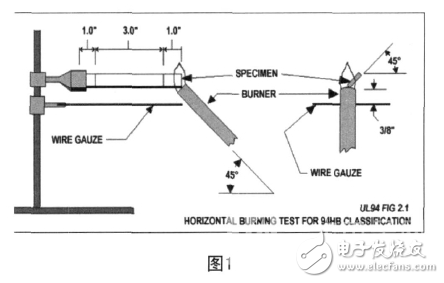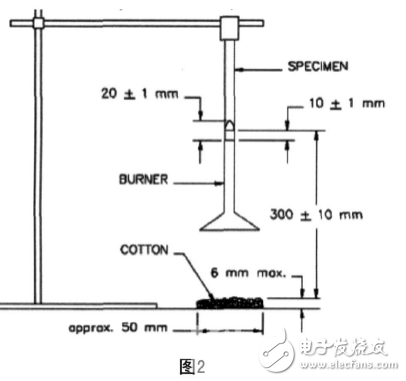UL94 mainly tests the flammability of related plastic parts such as equipment and electrical appliances. It can be applied to non-metallic materials, but there are still problems in building materials and decorative plastic materials. UL94's combustion of materials of different classes is mainly divided into the following five test methods: (1) 50W flame horizontal burning test UL94HB40, HB75 classification; (2) 50W flame vertical burning test V-0, V-1, V-2 classification; (3) 500W flame burning test 5VA, 5VB classification; (4) Vertical burning of soft samples of film materials, VTM-0, VTM-1 and VTM-2 classification; (5) Horizontal burning of foam materials HF-1, HF-2 and HBF classification. The following is a detailed explanation of each part of the sample holder, fire source and cabinet of UL94. UL94 horizontal vertical burning tester sample test procedure: 1. Horizontal burning test machine test HB classification The sample is placed horizontally. The size of the sample is 125mm & TImes; 13mm & TImes; the thickness (the large can not exceed 13mm), each marked 25mm and 100mm from the ignition end, and the sample is clamped at the distal end of the 25mm mark. The Bunsen burner is tilted at a 45-degree angle, and the position of the flame is not changed. The sample is applied for 30 s ± 1 s. For the test sample, the sample material is divided into two types: a self-supporting material and a non-self-supporting material. 1) Self-supporting materials The sample is clamped horizontally on the sample holder, and there is a horizontally placed metal mesh below. According to the provisions of Section 6.6 of GB94, GB/T2408:2008, the wire mesh is made of 0.40-0.45 mm in diameter. Made of steel wire, there are 20 holes per 25mm and cut into 125mm squares. According to Section 8.2.2 of GB/T 2408:2008, the free end of the specimen shall be kept at a distance of 10 mm from the metal mesh. 2) Non-self-supporting specimen According to Section 2.10A of UL94 and Section 8.2.3 of GB/T2408:2008, when the free end of the specimen cannot be maintained at a distance of 10 mm, a support frame should be placed under the specimen to ensure the freedom of the specimen. The distance between the end and the metal mesh is maintained at 10 mm, and the extended support frame is approximately 10 mm from the free end of the sample. At the clamped end of the sample, there must be sufficient clearance so that the fixture can slide freely to the side, and the support fixture should be retracted at the same speed when the sample burns. See Figure 1 for details. 2, vertical burning test machine V classification The sample is placed vertically, the sample size is 125mm & TImes; 13mm & TImes; thickness (large can not exceed 13mm), Bunsen burner vertical placement, according to the UL94 V classification of 3.14 and GB/T2408: 2008 section 9.2.4, the lamp mouth and test The sample is kept at a distance of 10 mm 1 mm, but the distance between the burner port and the sample is kept constant within 10 s 0.5 s during the change of the burning length of the sample, which requires the Bunsen lamp to be moved in a vertical plane. If there is melt or dripping during the combustion of the sample, the burner should be tilted 45 degrees to prevent the molten droplet from dripping into the burner. After applying the sample for 10s0.1s, the torch should be removed immediately. At least the distance of 150 mm from the sample is removed so as not to affect the afterburning of the sample. See Figure 2 for details. 3,500W flame burning test machine 5V classification For the 500W flame burning test, according to the provisions of 5V4.6 of UL94 and GB/T5169.17:2002, it is divided into the flammability test of the strip sample and the test of the flame resistance of the board sample. The strip sample is burned and tested for a vertical sample. The size of the sample is (125 mm ± 5 mm) × (13 mm ± 0.5 mm) × thickness (usually the required small thickness, the thickness cannot exceed 13 mm). The annular sample holder clamps the sample at a place of 6 mm, and a cotton pad with an area of ​​50 mm×50 mm is placed horizontally under the sample. The distance between the lower end of the sample and the cotton pad is 300 mm±10 mm. The Bunsen burner tube The angle between the axis of the axis and the vertical direction is 20 ± 5 degrees, and the sample is applied 5 times for 5 s ± 0.1 s each time, and the flame is burned at intervals of 5 s ± 0.1 s. According to the provisions of Section 8.2.3 of GB/T5169.17:2002, if the strip test sample has dripping, curling and elongation during the test, the position of the burner should be adjusted to make the blue cone flame The cone of the heart just touches the rest of the sample, which requires moving the Bunsen burner in a vertical plane without affecting the internal environment of the test chamber during the experiment. Remove the torch immediately after each application of the flame to avoid affecting the sample's afterburning. 2) Plate sample, the size of the sample is (150mm ± 5mm) × (150mm ± 5mm) × thickness (usually required small thickness, thickness can not exceed 13mm) Hold the specimen horizontally with a circular specimen clamp. The burner is at an angle of 20±5 degrees to the vertical plane, so that the cone top of the blue flame core just touches the center of the bottom surface of the plate-shaped sample, and the sample is applied 5 times for 5 seconds each time. 0.5s flame, interval 5s ± 0.5s, should be removed immediately after each flame is applied, so as not to affect the sample's afterburning. The samples were graded according to the time of burning. 4. VTM classification of vertical burning test for soft samples of film materials According to the UL94 increase of 5.5, for the material that is too thin, deformed, shrinking or burned to the sample holder, the sample size is 200mm × 50mm, and the longitudinal winding is wound on a rod with a diameter of 12.7mm, and the sample is vertically clamped. The distance between the bottom end of the sample and the top end of the burner tube is 95mm. The torch is placed vertically. A flame of 3s is applied to the sample. The distance from the flame to the sample is at least 150mm, so as not to affect the continuous burning of the sample, and wait until the sample stops burning. A flame of 3 s was applied to the sample. If the sample drops the melt or the combustible during each flame application, the burner is tilted to 45 degrees, and during the application of the flame, the burner moves slightly in the non-overlapping area of ​​the sample to avoid dripping. Drop the material into the nozzle. 5. HF classification of foam level test The Bunsen burner is placed vertically. According to the 5.2 part of GB/T8332:2008, the Bunsen burner has a length of 100±10mm and an inner diameter of 9.5mm±0.3mm. In 5.3, the specification of the fan-shaped flamethrower is installed in the lamp socket, and the wing top opening is specified. The internal length is (48 ± 1) mm and the internal width is (1.3 ± 0.05) mm. The sample holder is a 6.4mm mesh trawl made of stainless steel wire with a length of 215mm, a width of 75mm, a curved end at right angle, a height of 13mm and a diameter of 0.8mm. The distance between the front and rear of the box is from the front and rear of the box. The same, located above the box (175 ± 25) mm. According to the provisions of 6.2 of GB/T8332:2008, the sample size is (150mm±1mm)×(50mm±1mm), the thickness is not more than 13mm, the sample is placed horizontally on the tow net, and the front end of the sample is from the Bunsen lamp wing. Top top (13 ± 1) mm. Longkou Libo Insulating Material Co.,Ltd. , https://www.liboinsulation.com
